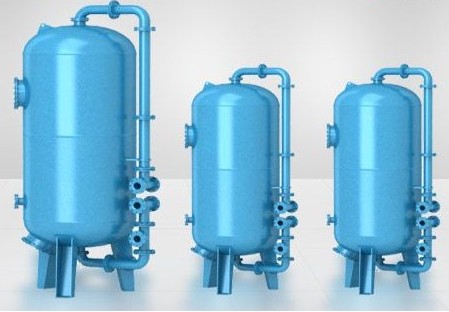1 . The activated Carbon adsorption filter cylinder adopts hydraulic simulation of long-diameter design, and adopts high-efficiency activated carbon with a reasonable particle size and a specific surface area of more than 1000 m 2 /g , so that it has both the upper-level special effect filtration and the lower-layer high-efficiency adsorption and other functions, greatly increasing production. Water purification and carbon life. 2 . After the treatment of activated carbon adsorption filter residual chlorine content: ≤ 0.1PPM . 3 . The performance of the odor, organic matter, colloid, iron and residual chlorine in the water is outstanding; 4 . It also plays an important role in reducing the turbidity and color of water bodies, purifying water quality, and reducing pollution to subsequent systems (reverse osmosis, ultrafiltration, ion exchangers, etc.).
1 Introduction
A tank filter device, generally made of stainless steel or fiberglass, is internally filled with activated carbon, which is used to filter free water, microorganisms, and some heavy metal ions in the water, and can effectively reduce the chroma of water.
Title Activated carbon filter is a commonly used water treatment equipment. As a pretreatment of water treatment desalination system, it can adsorb residual chlorine that can not be removed in the pre-stage filtration , which can effectively ensure the service life of the downstream equipment, improve the quality of the effluent, and prevent pollution. It prevents free oxygen poisoning pollution of the reverse osmosis membrane, ion exchange resin, etc. At the same time, it also adsorbs contaminants such as small-molecule organics that have leaked from the previous stage, and has obvious adsorption and removal effects on odors, colloids, pigments, and heavy metal ions in water, and it also has the effect of reducing COD . The SDI value of RO feed water can be further reduced to ensure that SDI<5 , TOC<2.Oppm .

2 equipment selection
The design parameters of the activated carbon filter should be based on the influent water quality, treatment requirements and the type of activated carbon, with reference to the operating experience of a similar power plant or determined through tests, and should comply with the following principles:
1 , should choose a good mechanical strength, adsorption speed, adsorption capacity of large activated carbon
2 , the filter speed of activated carbon filter can refer to the following table
Filter speed
Functional line speed ( m/h ) space speed [m?/(m?.h)]
Removal of organic matter ~105~10
Removal of free residual chlorine 20 ≦ 10
After the activated carbon filter is placed on the hydrogen ion exchanger, the filtration rate can be appropriately increased.
3 , activated carbon filters should be regularly backwashed.
3 Application area
Widely used in food, medicine, electronics, chemicals, industrial wastewater and other industries.
1 , can meet the hydraulic system requirements on the filtration accuracy, can block certain impurities into the system ;
2. The filter element should have sufficient strength and will not be damaged due to pressure ;
3 , the ability to flow through, the pressure loss is small ;
4 , easy to clean and replace. Installation points:
4 matters needing attention
1. The oil suction strainer at the pump inlet ;
2. High-pressure oil filter on the pump outlet oil ;
3. Low-pressure oil filter on the system return oil ;
4. A bypass filtration system installed outside the system.
5. Because the activated carbon adsorption function of the activated carbon filter has a certain saturation value, when the saturated adsorption capacity is reached, the adsorption function of the activated carbon filter will be greatly reduced. Therefore, the adsorption capacity of the activated carbon needs to be analyzed, and the activated carbon be replaced in time or via high pressure steam. Sterilization resumes.
It is worth noting that in the initial stage of using activated carbon (or during the initial stage of activated carbon replacement), a small amount of extremely fine powdered activated carbon may enter the reverse osmosis system along with the water flow, causing fouling of the reverse osmosis membrane flow path and causing operating pressure. Increases, decreases in water production, and increases in pressure drop in the system, and this damage is difficult to restore with conventional cleaning methods. Therefore, the activated carbon must be rinsed and the fine powder removed before the filtered water can be sent to the subsequent RO system.
5 Features
product
1 , high efficiency: 24 hours of continuous work, without shutdown backwash.
2. Low operating costs: No need for high lift and large flow backwash pumps.
3 , low maintenance costs: In addition to quartz sand filter material in the course of its operation without any rotating parts, low failure rate, maintenance costs.
4 , one-time investment is low: no need to set up a single coagulation pool, clarifier and other facilities, do not need backwash pumps and electric, pneumatic valves and other equipment, a small amount of engineering, one-time investment province.
5 , small head loss: a single filter material and filter cleaning time, head loss is small, the total head loss ≤ 0.5m .
6. Inlet water quality requirements are relaxed: long-term exposure to 150mg/L SS influent water quality, short-term withstand 300mg/L concentration of SS impact and the water quality remains unchanged.
7 , stable water quality and good filtering effect. The filter material can be cleaned in a timely manner to ensure high-quality, stable effluent effects and no periodic fluctuations in water quality.
8. Easy to modify and expand: The unit operation mode adopted can flexibly increase or decrease the number of filters according to the change of water quantity, and it is easy to modify and expand.
9 , small footprint, beautiful appearance: it will be the traditional three-stage reclaimed water treatment process as a whole, saving about 70-80% of the land ; appearance is more beautiful and compact.






